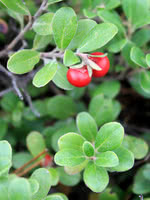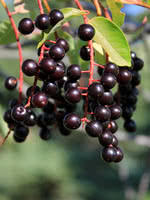Mon-Fri 9am - 5pm Mountain time
Bearberry vs Western Chokecherry
Arctostaphylos uva-ursi
Prunus virginiana var. demissa
NOT AVAILABLE THIS SEASON - MIGHT RETURN
Bearberry is a dwarf shrub known for its creamy pink flowers and red edible fruits.
It is great as a filler in gardens and flowerbeds in place of invasive ground cover plants, like English Ivy.
Bearberry will attract hummingbirds, butterflies and bees to your property. It is one of the top 12 plants recommended by the Alberta Native Bee Council to support pollinators.
Western Chokecherry is a shrub or small tree commonly used for farmstead and field windbreaks.
It produces white flowers in the spring and edible dark purple fruit that matures between September and October. Its cherries are great for making for making jams, jellies or wine, but are not very palatable for raw eating.
Bearberry Quick Facts
Western Chokecherry Quick Facts
Toxicity: toxic to horses, cattle, etc.)

